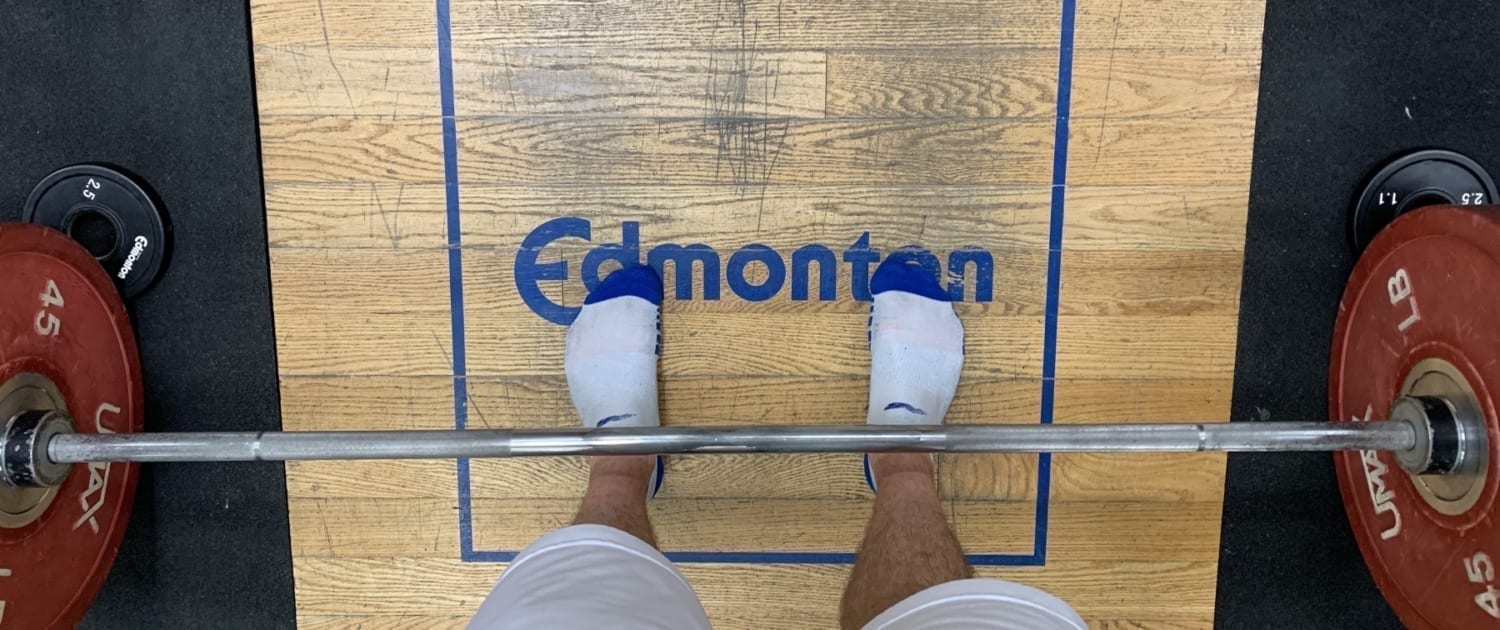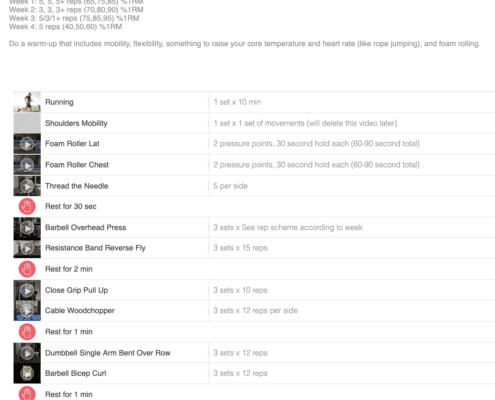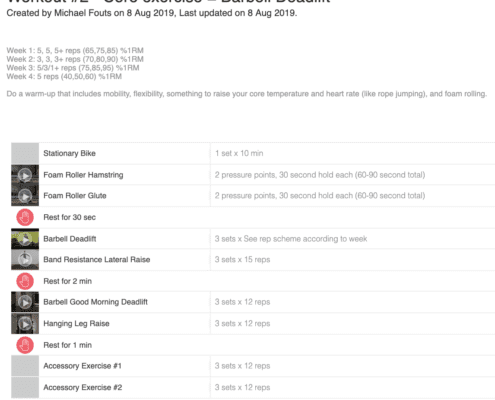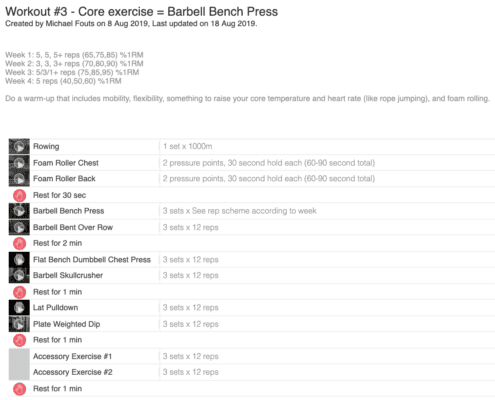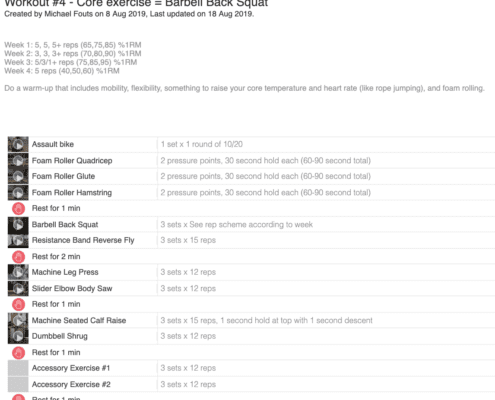The 5/3/1 Strength Program: What It Is and How To Do It
The 5/3/1 Strength Program, the brainchild of Jim Wendler, is a program I’ve done more than once and have always gotten stronger while doing this program; it’s also been a program that has complemented my amateur triathlon training nicely. The following is a summary of what it is and how to do a modified version of it that I created.
I’ve created a downloadable workout tracking sheet that you can use – see the bottom of this page for that.
What is the 5/3/1 Workout Program?
All workouts are centered around what are the “Core Exercises/Lifts,” which are: Barbell Shoulder Press, Barbell Deadlift, Barbell Bench Press, Barbell Back Squat. The goal is to train 3-4 days a week with the program lasting 4 weeks. Within each week you are targeting different percentages of your one-rep max (1RM), with different rep variables each week (see table below). You repeat the 4-week cycle again, calculating new 1RM based on the numbers you put up in the 4 weeks of the program, for the desired length of your strength training block (specific time spent focused on a certain goal); some people will take breaks and do a hypertrophy block for 6-8 weeks, which can complement strength gains and help avoid plateaus, others will do a power development block which is a natural progression after doing a strength training block.
In each workout the core lifts are complemented with assistance work, which is termed as Accessory work in the workouts template and screenshots below, which aims to build muscle, prevent injury, and create a balanced physique. Examples of accessory exercises could be:
- Barbell Shoulder Press: Seated Arnold Dumbbell Shoulder Press, Chin ups, Landmine Shoulder Press, Cable Tricep Extensions
- Barbell Deadlift: Back Extensions, Lat Pulldown, Nordic Hamstring Curls, Dumbbell Hammer Curls
- Barbell Bench Press: Cable Chest Fly, Lateral Dumbbell Raise, Close Grip Bench, Front Dumbbell Raise
- Barbell Back Squat: Dumbbell Lunges – any variation will do, Plank, Back Extensions, Machine Leg Extension
Before starting the program, you are going to need to calculate your 1 RM. You can do that here using some of your old workout data if you have it: Click here to calculate your own.
Here is some data when I did this program once:
- Core Lift:
- Flat Barbell Bench Press:
- Barbell Deadlift:
- Overhead Barbell Shoulder Press:
- Barbell Back Squat:
- Predicted 1 RM (lbs.):
- 220
- 420 *without belt or straps
- 144
- 325
Program % 1RM and Repetition (rep) prescription:
- % 1 RM
- Week 1:
- Week 2:
- Week 3:
- Week 4:
- % 1 RM
- 65, 75, 85
- 70, 80, 90
- 75, 85, 95
- 50, 60, 70
- Reps:
- 5, 5, 5+
- 3, 3, 3+
- 5, 3, 1+
- 5, 5, 5
“rep” + = as many as you can, note in week 4 there is no “+”
What this Looks Like:
4 Day Split
Click here to download a workout and tracking sheet for this program.
A few closing points:
- Last week, week 4, set 3 is 5 and not 5 +
- You can do the workouts in whatever order you’d like but it’s suggested not to do the parallel squat and deadlift back-to-back, or the bench press and overhead press back-to-back.
- You can do 3 workouts instead of 4 workouts in a given week by merging an upper body + lower body workout together. Eg. Parallel squat + bench press are done together; if you choose to do this with your workouts, these days will be a little longer and get rid of at least 2 accessory exercises.
- One of the things I did, and I encourage you to do is: record videos of yourself doing the various lifts from different angles – front, side, back. It will allow you to assess your technique and biomechanics more thoroughly and pick up things you might otherwise not see. It will also allow you to perform the lift and then review your technique after, instead of trying to check it while you’re performing the movement – not ideal when going heavy.
- Be in an isocaloric, or hypercaloric state throughout your days and weeks while doing this program for best results. You’ll never maximize strength, or hypertrophy (muscle building), results when in a caloric deficit.
- You can do different variations of the core lifts, eg. front squat instead of back squat.
Click here to download a workout and tracking sheet for this program.
Need some help with the program? If you have a quick question, shoot me a message, or if you want some more serious help check out my Work With Mike page.
-Mike
 Author Bio: Michael Fouts
Author Bio: Michael Fouts
Mike blogs on this website – michaelfouts.com – obviously, but also owns a Mobile and Online Personal Training Company called OverHaul Fitness. Mike loves helping people manipulate their body composition; losing weight while retaining muscle, or putting muscle on while minimize fat gain. Mike’s spare time is spent being active (hockey, squash, triathlons), eating sandwiches or beef jerky, or watching thought provoking movies or tv series (like Westworld). Connect with Mike via email: Mike@overhaulfitness.ca, or Social Media – links below:
If you’d like to work with me as an Online client you can find out more information here.
If You Want To Be In The Know About…
New exercises to try, recipes to make that are both healthy & delicious, or relevant workout programs, meal plans, or popular blog posts? Put your email below and i’ll add you to my inner circle email list.

